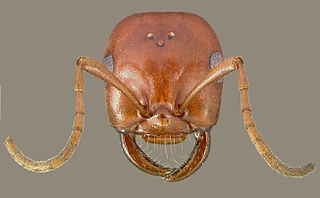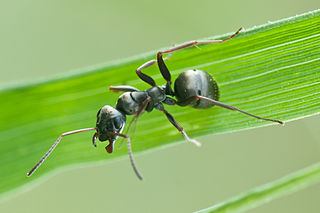
Formica is a genus of ants of the subfamily Formicinae, including species commonly known as wood ants, mound ants, thatching ants, and field ants. Formica is the type genus of the Formicidae, and of the subfamily Formicinae. The type species of genus Formica is the European red wood ant Formica rufa. Ants of this genus tend to be between 4 and 8 mm long. Ants belonging to the Formica genus possess a single knob or bump located between their thorax and abdomen. These ants primarily feed on honeydew, a sugary liquid produced by aphids. Formica ants appear to take on a shepherding role with smaller aphids, relocating them to different parts of plants to ensure a continuous food source for the aphids. By doing so, the ants can establish a relatively sustainable honeydew supply for both themselves and their colony.

Formica Laminate is a laminated composite material invented at the Westinghouse Electric Corporation in the United States in 1912. Originally used to replace mica in electrical applications, it has since been manufactured for multiple applications. It has been produced by Formica Group manufacturing sites across the globe since. Formica Group are best known for the company's classic product: a heat-resistant, wipe-clean laminate of paper with melamine resin.

The cinnabar moth is a brightly coloured arctiid moth found as a native species in Europe and western and central Asia then east across the Palearctic to Siberia to China. It has been introduced into New Zealand, Australia and North America to control ragwort, on which its larvae feed. The moth is named after the red mineral cinnabar because of the red patches on its predominantly black wings. The species was first described by Carl Linnaeus in his 1758 10th edition of Systema Naturae. Cinnabar moths are about 20 mm (0.79 in) long and have a wingspan of 32–42 mm (1.3–1.7 in).

The Formica rufa group is a subgeneric group within the genus Formica, first proposed by William Morton Wheeler. This group contains the mound-building species of Formica commonly termed "wood ants" or "thatch-mound ants", which build prominent nests consisting of a mound of grass, litter, or conifer needles. The species Formica rufa or the red wood ant is the type species of this subgroup.

Formica rufa, also known as the red wood ant, southern wood ant, or horse ant, is a boreal member of the Formica rufa group of ants, and is the type species for that group, being described already by Linnaeus. It is native to Eurasia, with a recorded distribution stretching from the middle of Scandinavia to the northern Iberia and Anatolia, and from Great Britain to Lake Baikal, with unconfirmed reportings of it also to the Russian Far East. There are claims that it can be found in North America, but this is not confirmed in specialised literature, and no recent publication where North American wood ants are listed mentions it as present, while records from North America are all listed as dubious or unconfirmed in a record compilation. The workers' heads and thoraces are colored red and the abdomen brownish-black, usually with dark patches on the head and promensonotum, although some individuals may be more uniform reddish and even have some red on the part of the gaster facing the body. In order to separate them from closely related species, specimens needs to be inspected under magnification, where difference in hairiness are among the telling characteristics, with Formica rufa being hairier than per example Formica polyctena but less hairy than Formica lugubris. Workers are polymorphic, measuring 4.5–9 mm in length. They have large mandibles, and like many other ant species, they are able to spray formic acid from their abdomens as a defence. Formic acid was first extracted in 1671 by the English naturalist John Ray by distilling a large number of crushed ants of this species. Adult wood ants primarily feed on honeydew from aphids. Some groups form large networks of connected nests with multiple queen colonies, while others have single-queen colonies.

Polyergus is a small genus of ants with 14 described species. They are also referred to by the names "slave-raiding ants" and "Amazon ants". They are characterized by their habit of raiding nests for workers.

Formica fusca is a black-colored ant commonly found throughout Europe as well as parts of southern Asia and Africa. It has the common names silky ant or dusky ant. The range within the palaearctic region extends from Portugal in the west to Japan in the east and from Italy in the south to Fennoscandia in the north. Populations from North America have been split off as a separate species, Formica subaenescens. F. fusca nests are usually found in rotten tree stumps or under stones in clearcut areas and along woodland borders and hedgerows. The species also often occurs in urban areas, feeding on honeydew secreted by the aphids found on weeds.

Formica polyctena is a species of European red wood ant in the genus Formica and large family Formicidae. The species was first described by Arnold Förster in 1850. The latin species name polyctena is from Greek and literally means 'many cattle', referring to the species' habit of farming aphids for honeydew food. It is found in many European countries. It is a eusocial species, that has a distinct caste system of sterile workers and a very small reproductive caste. The ants have a genetic based cue that allow them to identify which other ants are members of their nest and which are foreign individuals. When facing these types of foreign invaders the F. polyctena has a system to activate an alarm. It can release pheromones which can trigger an alarm response in other nearby ants.

Formica pratensis, the black-backed meadow ant, is a species of European red wood ant in the family Formicidae.

Formica sanguinea, or blood-red ant, is a species of facultative slave-maker ant in the genus Formica characterized by the ability to secrete formic acid. It ranges from Central and Northern Europe through Russia to Japan, China, the Korean Peninsula, Africa and also the United States. This species is coloured red and black with workers up to 7 mm long.

Mauro Abel Formica is an Argentine former professional footballer who played as an attacking midfielder. He is nicknamed El Gato.
Lautaro Roque Formica is an Argentine football player currently playing for Defensores de Belgrano.

Phalera flavescens is a nocturnal moth of the family Notodontidae. It is found in Taiwan, China, Japan and Korea.
Sofie Formica is an Australian radio and television presenter and actress. She is best known for hosting Queensland-based lifestyle show The Great South East on the Seven Network from 1997 until 2016. Afternoons with Sofie Formica was launched on Brisbane radio station 4BC in October 2021.

Salvatore Formica, best known as Rino Formica, is a former Italian politician.
Daniele Formica was an Irish-born Italian actor, voice actor, theatre director, playwright and television personality.
Paul Formica is an American restaurateur and former Republican member of the Connecticut State Senate, representing the 20th District since 2015. Previously, Formica was the First Selectman of the town of East Lyme from 2007 to 2015.












